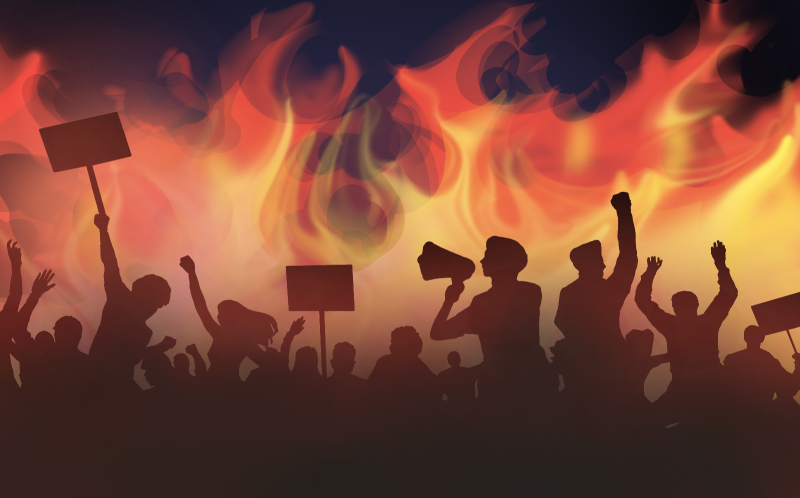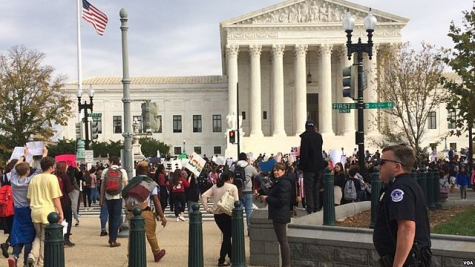The science behind mob mentality
January 29, 2021
On Jan. 6, pro-Trump protesters stormed the US Capitol, roamed the halls, broke windows, and pounded open doors. Guns were drawn. A Trump flag hung over the Capitol. The mob seized the offices of the House of Representatives, the Senate podium, and the presiding officer’s chair, where one yelled, “Trump won the election.” The reek of tear gas soiled the symbol of our democracy.
What happened on that day was clear; a seemingly peaceful protest had turned violent. Surprisingly, the participants of the capital riots aren’t all Proud Boys and QAnon extremists. For example, participants spotted included the ex-Olympic swimmer Klete Keller; another was Aaron Mostofsky, the 34-year-old son of a Brooklyn judge; and Thomas Robertson, an off-duty police officer. By taking a closer look, it’s clear that most of the people participating in this incident were like you and me; law-abiding citizens.
This brings up some questions like, why would a protest evolve into a mob? Why did they suddenly turn violent? What was the purpose of storming the Capitol? And did everyone share a coherent purpose?
Even the New York Times questions the clear definition of this mob: “Was this an angry throng, a chaotic demonstration, a protest turned ugly or a deliberate insurrection — or some combination of them all?”
Each participant’s purpose in storming the capitol may remain a mystery, but one thing that can be uncovered is the science behind the formation of mobs, also referred to as mob mentality, the phenomenon where people profess their beliefs and act out in ways which they would have never considered independently.
According to Psychology Today, when like-minded people in a group reinforce one another’s viewpoints, it strengthens the opinions of each person in the group. In other words, within a mob, people who support other mob participant views will only make that participant more confident in supporting their own ideas.
This influence from other people can sometimes be so strong that it blurs the line of righteousness. This influence is observed in everyday life. For example, the purchase of a new video game by one person, might influence their friend to also buy the game. Or when one sibling gets a phone, the other sibling might also beg for a phone. In fact, this same principle applies to a mob, as when one person throws a rock, people who saw the throw would think it’s acceptable to throw rocks.
Psychologist Robert Cialdini writes in his book, Influence: The Psychology of Persuasion, “Whether the question is what to do with an empty popcorn box in a movie theater, how fast to drive on a certain stretch of highway, or how to eat the chicken at a dinner party, the actions of those around us will be important in defining the answer.” In a way, the opinions of others shape the manner in which one acts.
Not only does mob mentality tamper with one’s morals, but it also tampers with one’s reason. A historical example of mob mentality was the Salem Witch Trials, where innocent women were killed without the physical evidence that they were actually possessed.
There are several theories formed regarding the potential causes of mob mentality.
Dr. Wendy James lists three: Contagion Theory, Convergence Theory, and Emergent-Norm Theory.
Contagion theory claims that “crowds exert a hypnotic influence on their members that results in irrational and emotionally charged behavior often referred to as crowd frenzy.” On the other hand, the Convergence theory says that violence within masses of people is the “result of like-minded individuals coming together.”
Lastly, the Emergent-Norm Theory states a mixture of the two previous theories is what leads to mob behavior. In essence, a riot can be caused by either conforming to the actions of the majority or the group is already made up of like-minded individuals. Perhaps one of these theories could have been the reason for the Capitol riot.
The idea that your opinions and actions are directly influenced by other people, both negatively and positively, is also supported by Henry David Thoreau.
Brain Word Magazine quotes the famous philosopher, who said “The mass of men lead lives of quiet desperation,” which “Henry David Thoreau wrote famously in 1847 before embarking on a trip to Walden Pond, where he lived largely in seclusion for two years. He hoped that somewhere deep in the New England wilderness he’d be able to find his true self.”
Though you don’t necessarily need to isolate yourself for years, it may be beneficial to discover and define your own beliefs and opinions before listening to people around you.
Another factor that contributes to the formation of mobs is the emotional side of mob mentality. As years of frustration, gouging hatred, and resentment propel people into action at a protest, the crowd would be engulfed with emotions. These emotions carried forth by everyone makes the protest prone to spark violence. Any incident, such as an innocent death or police attacking, might ignite the fuse to an explosive, violent mob, quickly transforming a protest into a riot.
According to Ken Eisold, when protests turn into mobs, “one is immersed, engulfed. And it can become an exuberant experience, a joyful release for long-suppressed emotions. It can also become manic, driven, a means of restlessly seeking new outlets.”
The emotionally unstable and driven mob also offers a sense of belonging. Similar to what is felt by audiences at rock concerts and sports games, in the heat of everything only emotion drives the crowd. The only difference is that mobs tend to easily get out of hand since they lack a coherent purpose. However, this does not justify the actions of mobs, rather the emotional aspect of mob mentality shows that anyone can get caught up in the energy.
Forbes proposes several solutions to the problems of mob mentality in the context of social media.
Issues like potential miscommunications and the desire to get more likes and approval from others can be lessened with methods like doing “your research before forming an opinion and being open to additional information that comes your way.”
Forbes also suggests being “comfortable with standing out, even if that means standing alone.” In other words, it is important to define your individuality before listening to claims without reason from others that unbalance your judgment in those situations.
During riots, it’s human nature to follow the majority and the beliefs of others. The common people have fueled these mobs, and it was the common people who fueled the assault on our capital. This will be a constant reminder of the polarization faced in our nation, and with President Biden’s inauguration, hopefully our nation’s democracy and unity can be restored.







